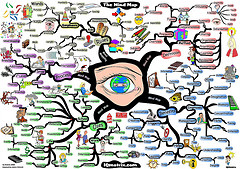A recent The Smarter Home Office blog post quoted John Cleese saying that we don’t get our ideas from our laptops. Well if you shouldn‘t use your computer to create, then what do you use? A big piece of paper, colored pens and your imagination!
Remember being taught in school how to develop an outline? Most of us approach solving problems, planning projects, or developing ideas in a linear, left-brain manner. We need our left brain to prioritize and order tasks and goals, but that is only half of your thinking power. As you are doing logical left brain thinking what do you do with those miscellaneous ideas that pop up? If you are forcing yourself to do only sequential thinking then you will lose those bits and pieces. Often those bits and pieces are helpful insights or important details that will either enhance a project or make executing it easier.
One technique is using conceptual maps, semantic network or mind mapping. This is a tool for creating a fluid diagram of the various aspects of a problem and/or project. You start in the center of the page with the name of the project or goal and then draw branches out from the center with various tasks or issues and then sub-branches with more and more detailed aspects of the project at hand. This not only allows you to look at the big picture and the small picture simultaneously, this technique is excellent for supporting the natural flow of ideas and associations, unhindered by a need to prioritize, judge or censor. (Ordering and editing comes later) The goal is to get all of your thoughts and ideas around a project or goal down on paper, no matter how illogical or unconnected they may appear at the time.
Learn more about mind mapping in this Wikipedia entry. The ten steps listed here are for guidance. Colored pens are optional (they make the exercise more fun).
There are several computer templates and software programs for mind mapping, but I think they get in the way of the best part of the mapping experience – the flow of your thoughts. On a computer you need to move the mouse, set up the branch or bubble and then type in the words. Plus computers are, by their very nature left brain and linear. If you need to present a cognitive map as part of a presentation, then consider using a software program to do a cleaned up version after you have done it on paper. When your mind/cognitive map is complete – then you can convert it into a prioritized outline or sequential timeline.
When I need to develop a project, marketing plan or presentation I use a big piece of architects trace paper, or you can use brown kraft paper, the back of wrapping paper or a large write board. Or if you have painted a wall in your office with IdeaPaint you will have a larger space on which to plot your ideas. And then literally step back and get a new perspective on what you have produced.
How do you brainstorm with yourself? How do you get your creativity jump started and captured?
A great website Think Like a Consultant has posted a review of The Smarter Home Office. Check ou the review and the website here.
Photo by zipckr
